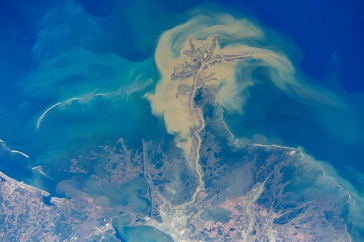Research Finds Water Quality in Gulf of Mexico Improves When Adding Social Costs to Carbon Emissions

The mouth of the Mississippi River, emptying into the Gulf of Mexico south of New Orleans, Louisiana, is pictured from the International Space Station. Credit: Roscosmos/NASA.
DURHAM, N.H.—U.S. Climate policies can offer options for putting climate change efforts into place that solve environmental problems like excessive carbon dioxide in the atmosphere created by greenhouse gas emissions. Research led by the University of New Hampshire took a closer look at what would happen to agriculture if there was an extra cost, or so-called social cost, added to fossil fuels, which are essential for making fertilizer used in farming. They found that while CO2 emissions would decline by as much as 50%, the cost of fertilizer would rise leading to a significant benefit on water quality by lessening fertilizer runoff contributing to the Gulf of Mexico’s dead zone—a low-oxygen area that struggles with harmful algal blooms that threatens marine life.
“Excessive fertilizer use creates a growing number of water quality concerns so we wanted to explore the consequences of applying a social cost to fossil fuel prices which should reduce fertilizer use and decrease the amount of runoff going into the Mississippi River Basin and on to the Gulf of Mexico, an important fishery in the U.S.,” said Shan Zuidema, research scientist at UNH’s Earth System Research Center and lead author. “Our models showed that with this climate policy, U.S. carbon emissions could significantly decline but we could also see about a 3% to 4% reduction of the Gulf of Mexico dead zone in an average year.”
In the study, published in the journal Proceedings of the National Academy of Sciences (PNAS), researchers from UNH, Purdue University and the University of Wisconsin-Madison used four different models that looked at various factors making up the world economy. They focused on data from the global economy, U.S. agricultural economies, agroecology and hydrology/water quality to capture the impacts of the climate change mitigation policy on agriculture and the resulting water quality co-benefits. They analyzed a policy that would assign a range of social costs to fossil fuel-based CO2 emissions. The policy would raise energy costs and increase the price of nitrogen fertilizer production.
The researchers then considered three different levels of social costs applied to the fossil fuel and found at the highest carbon price the cost of nitrogen fertilizer could rise by roughly 90%. This could lead to upwards of a 16% decline in fertilizer application for corn production across the Mississippi River Basin and a roughly 9% decline in fertilizer loss to the environment. Corn and soybean production would decline by about 7%, increasing crop prices by 6%, while nitrate leaching would decline by about 10%. Nitrates entering the environment are removed in various ways as they move through the watershed, so the decline in nitrogen leaving the watershed at the mouth of the Mississippi River was somewhat less (roughly a 9% reduction).
“Implementing a carbon price that reflects its social cost allows the U.S. to meet its commitment to the Paris Accord while significantly improving water quality,” said Tom Hertel, professor of agricultural economics at Purdue University and project principal investigator. “Our models showed that with this range of climate policies, U.S. carbon emissions could decline by 29% to 50%, depending on the stringency of the carbon pricing. This represents 4.6% to 8% of global carbon emissions and satisfies the range of reductions outlined in the Paris Accord.”
Researchers also considered the additional benefits of restored wetlands to mitigate nitrogen loading to reduce hypoxia in the Gulf of Mexico and found a targeted wetland restoration scenario approximately doubles the effect of a low to moderate social cost of carbon.
The team hopes these findings provide important context for policy makers to consider all aspects of climate mitigation, as well as for those that want to consider alternatives for reducing contamination to the Gulf of Mexico.
Co-authors include Wilfred Wollheim and Stephen Frolking, both from UNH; Jing Liu, Maksym Chepeliev, David Johnson, Uris Baldos and Tom Hertel, all from Purdue University; and Christopher Kucharik, from the University of Wisconsin-Madison.
Funding for this research was provided by the Innovations at the Nexus of Food, Energy and Water Systems project funded by the National Science Foundation. Partial funding was provided by the New Hampshire Agricultural Experiment Station through the USDA National Institute of Food and Agriculture
The University of New Hampshire inspires innovation and transforms lives in our state, nation and world. More than 16,000 students from 49 states and 82 countries engage with an award-winning faculty in top-ranked programs in business, engineering, law, health and human services, liberal arts and the sciences across more than 200 programs of study. A Carnegie Classification R1 institution, UNH partners with NASA, NOAA, NSF, and NIH, and received over $210 million in competitive external funding in FY23 to further explore and define the frontiers of land, sea and space.
Latest News
-
April 15, 2025
-
Research Finds Rural Americans Carry Heavy Burden Accessing Social Security Benefits and InformationMarch 27, 2025
-
March 25, 2025
-
March 17, 2025
-
March 12, 2025













































